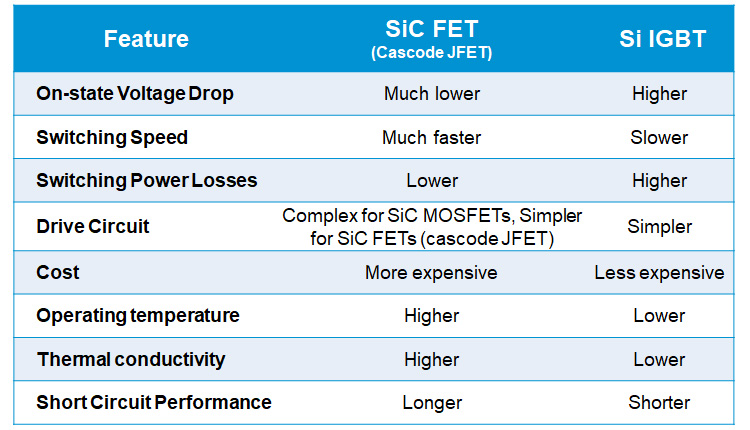
An entire industry perked up its ears when Qorvo announced QSPICE™ in July 2023, and for good reason. This free circuit simulation software is built specifically to serve analog and power designers and is poised to save companies countless hours and thousands of dollars by reducing design time. How did Qorvo come to offer their own flavor of the popular SPICE simulation tool, and what does this mean for design engineers? This article discusses the history of SPICE, how QSPICE supports Qorvo’s growing silicon carbide (SiC) power management portfolio, and the advantages of SiC technology.
First, let’s start with a little background on how Qorvo has developed into the leading RF and power provider that engineers count on today. In 2015, TriQuint Semiconductor and RF Micro Devices merged to become Qorvo. Since then, the company has maintained its prominent position as a manufacturer of GaN and GaAs RF power amplifiers, switches, SAW and BAW filters, front-end modules, and related devices. Over the last few years, Qorvo has also invested heavily in DC power and power management. With the acquisition of Active-Semi International in 2019, Qorvo gained formidable capabilities in power management devices, including its power application controller that integrates a 32-bit ARM Cortex processor. Qorvo also acquired United Silicon Carbide in 2021 and the result is a broad portfolio that includes a host of diodes, FETs and JFETs based on silicon carbide (SiC).
Adding DC power to an overwhelmingly RF-based company may appear odd at a superficial level, but look deeper and you can see the company’s reasoning. It makes a lot of sense when considering the convergence toward the “electrification of everything.” And rather than investing in legacy technology like silicon insulated gate bipolar transistors (IGBTs), Qorvo is focusing on technology that has well-known advantages over IGBTs in applications greater than 600VDC.
About Qorvo’s QSPICE Simulator
The “Simulation Program with Integrated Circuit Emphasis,” more commonly known as SPICE, was first announced at the Sixteenth Midwest Symposium on Circuit Theory in 1973 by Professor Donald Pederson of the University of California, Berkeley. At the time, Berkeley was ground zero for the development of simulation tools for ICs. Fifty years and numerous variations later, SPICE remains the most widely used simulator in the industry. However, many SPICE variations are either too slow or they are limited in functionality. Additionally, some have a less-than-stellar reputation for reliability in today’s design and development environment. For example, many SPICE-based simulators can have up to 15% failure rates.
Taking on the Q from Qorvo, the latest iteration of SPICE is QSPICE. QSPICE is the work of creator Mike Engelhardt, who also developed LTspice®, the industry’s most widely used version of SPICE. Like LTSpice, QSPICE has no use restrictions and no limits on nodes, components, or subcircuits. QSPICE also improves design productivity by increasing simulation speed, functionality, and reliability. Qorvo says QSPICE can reduce simulation run times and achieve a 100% completion rate.
QSPICE can also help engineers analyze power integrity and noise in power management and mixed-signal designs where these are critical metrics, especially for SiC-based devices that operate at high frequencies. It simulates parasitic impedances in interconnections and power delivery networks to analyze power integrity in a circuit. It does this by using netlists extracted from other tools or its own calculations from dimensions and metal alloy data.
QSPICE has a growing free model library that is continuously updated with new power management and SiC devices. QSPICE also has an active forum and video library to support users.
Why SiC Is So Important
Like Qorvo’s much-used gallium nitride and gallium arsenide technologies, SiC is a compound semiconductor. Before their acquisition, United Silicon Carbide had been a leading manufacturer of silicon carbide-based semiconductors such as FETs, JFETs, and diodes since 1999. Its expertise in the use of SiC for DC power devices nicely complements Qorvo’s existing expertise in SiC-based RF devices such as GaN-on-SiC.
The Science Behind SiC’s Success
From a scientific standpoint, SiC technology is an excellent choice as a semiconductor base material. It has 10 times the breakdown strength of silicon, so it can withstand higher voltages before breakdown. It can also operate at much higher temperatures without significant performance degradation. Since it’s a wide bandgap semiconductor material, SiC has inherently higher power density to handle higher currents than silicon. It also has thermal conductivity second only to diamond, which allows heat to be rapidly dispersed at the die level. Parenthetically, it’s also why SiC, rather than silicon, is used as the insulating material for high-performance GaN RF power amplifiers.
SiC MOSFETs also operate at higher frequencies, which translates into faster switching speeds than IGBTs, an important parameter for increasing the performance of power converters and other components. They’re also smaller and lighter, which is important for any power system where size and weight are critical metrics. Reliability is also one of SiC’s inherent advantages because it’s more robust than silicon, which is essential for applications such as power grids and transportation systems that operate in hostile environments and must remain in place for decades.
SiC devices have lower on-resistance than traditional silicon devices, which translates into reduced conduction losses. These devices also have significantly lower switching losses, providing a much lower total loss when combined with the reduced conduction losses. The lower total loss results in higher efficiency, a key metric for high-frequency switching applications like motor drives and power inverters. In short, SiC-based devices allow designers to create more compact power electronics systems with higher energy conversion efficiency and less need for complex structures to support heat dissipation. Finally, SiC MOSFETs generate lower levels of electromagnetic interference, which is a crucial requirement in an electric vehicle.
From a design and manufacturing perspective, it is important to note the cost-performance break point. SiC advantages are particularly apparent when at 600V and greater. At voltages below 600V, silicon-based (Si) devices are more competitive in performance and may be the preferred cost-performance choice depending on the specific application.
Overall, these advantages are leading to the growing adoption of SiC MOSFETs into higher voltage applications and will likely replace IGBTs in all but systems requiring the ability to handle extremely high voltage and current. For those extreme applications IGBT devices will likely continue to be dominant for the foreseeable future.
SiC MOSFET and Silicon IGBT Performance Comparison

Summary
In summary, Qorvo’s entry into the programmable power market is a good investment in a rapidly electrifying future, and QSPICE will play an important role in the company’s success. Its reliability and lack of restrictions, with no limits on nodes, components, or subcircuits, make it an invaluable tool for engineers seeking to take advantage of SiC-based power devices in their designs.
More Reading
Read about the UJ4SC075005L8S 750 V, 5.4 mohm SiC FET
About Kirk Barton

Kirk Barton is a Technical Marketing Manager for Power Products at RFMW. Leveraging 35 years of industry experience and a degree in Electrical Engineering, Kirk specializes in high power applications using wide bandgap technologies. Kirk enjoys being part of the RF industry’s innovative environment and witnessing the positive impact that technological advances have on integration, efficiency, and end applications.

